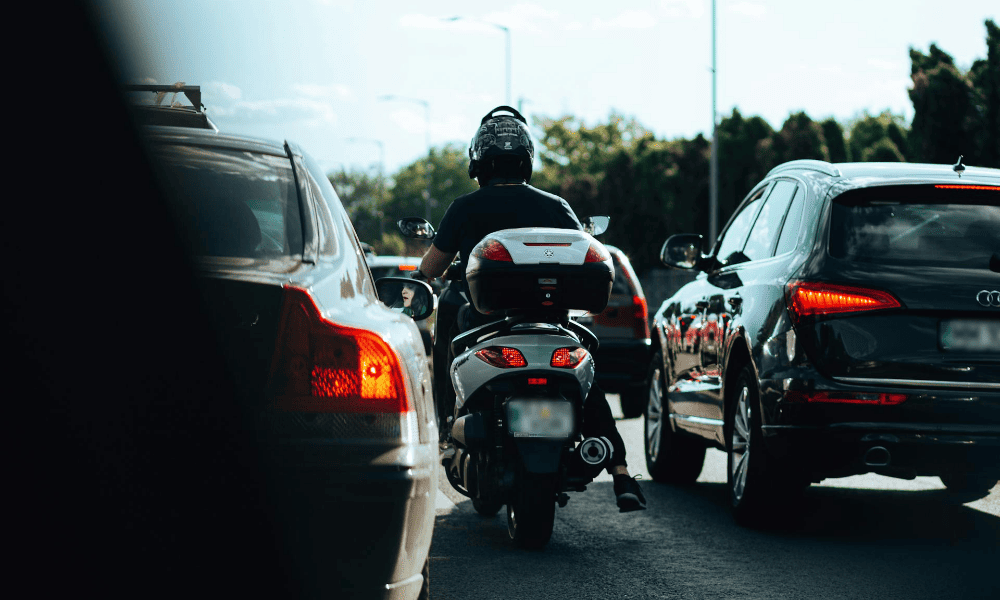
Lane splitting, the practice of riding a motorcycle between lanes of traffic, is a topic debated among many states in the US. While some argue that lane splitting can reduce traffic congestion and improve safety for motorcyclists, others believe that it poses significant risks.
For motorcyclists in Nebraska, understanding the state’s laws on lane splitting is important to ensure compliance and avoid potential legal issues. If you have questions about Nebraska’s motorcycle laws or have been involved in a motorcycle accident, contact us today at (402) 241-5020.
What Is Lane Splitting?
Lane splitting, also known as white-lining or stripe riding, refers to a motorcyclist riding between two lanes of traffic moving in the same direction. Typically, this maneuver is done to bypass slower-moving or stopped traffic.
Another term that you may have heard is “lane filtering.” Lane filtering is similar to lane splitting but usually occurs at slower speeds or only when traffic is stopped or moving very slowly. Motorcycle riders filter through the gaps between vehicles at a congestion point or traffic signal.
Lane sharing is a term used to describe a motorcyclist and another vehicle sharing the same lane side-by-side. This practice is common among motorcyclists riding in groups who want to travel more closely together.
Lane Splitting Laws in Nebraska
Currently, Nebraska law does not permit lane splitting, lane filtering, or lane sharing. Motorcyclists are required to remain within a single lane and cannot pass between rows of moving or stopped vehicles.
Nebraska Statute 60-6,308 states that, “The operator of a motorcycle shall not overtake and pass in the same lane occupied by a vehicle being overtaken.” Additionally, the law prohibits motorcycles from operating between lanes of traffic or adjacent lines or rows of vehicles.
Essentially, these statutes mean that lane splitting is illegal in Nebraska.
While lane splitting is not allowed in Nebraska at this time, there is a possibility this law could be amended at some point in the future. The state recently made a change to its laws regarding the use of motorcycle helmets. As of January 1, 2024, individuals who meet certain criteria are allowed to ride without a helmet in Nebraska.
The Pros and Cons of Lane Splitting
At this time, California is the only state where lane splitting is legal. While some argue there are practical advantages to lane splitting, others counter that it poses significant safety risks.
Let’s consider some of the pros and cons of lane splitting.
Pros of lane splitting
The following are what some argue to be benefits of allowing motorcyclists to ride between lanes:
- Reduced traffic congestion: Lane splitting may help alleviate traffic congestion by allowing motorcycles to move through slow or stopped traffic. This can lead to more efficient use of road space and potentially reduce the overall volume of vehicles in traffic jams.
- Decreased risk of rear-end collisions: Motorcyclists stopped in traffic are vulnerable to rear-end collisions. Land splitting can reduce this risk by allowing motorcyclists to keep moving and avoid being trapped between vehicles.
- Shorter commute times: By bypassing traffic jams, motorcyclists can arrive at their destinations more quickly. This not only saves time for riders but can also reduce the time other drivers spend in traffic by removing motorcycles from lanes.
- Increased safety awareness: According to a study conducted by UC Berkeley, lane-splitting motorcyclists were more likely to use better helmets and travel at lower speeds. A motorcyclist doing a lane split was also found to be less likely to be under the influence of alcohol while riding.
- Environmental benefits: Motorcycles are typically more fuel-efficient than cars. By reducing the amount of time idling in traffic, lane splitting can contribute to lower fuel consumption and decreased emissions.
Cons of lane splitting
The following are some potential hazards of allowing lane splitting:
- Safety issues: One of the main arguments against lane splitting is the potential for accidents. The maneuver requires a high level of skill and awareness from the rider. Additionally, sudden lane changes by cars can result in a collision.
- Visibility concerns: Motorcycles are smaller and less visible than other vehicles and therefore, more difficult to see – especially when lane splitting. Drivers may not always be aware of a motorcycle’s presence, increasing the risk of accidents.
- Insurance and liability complications: In the event of an accident, lane splitting can complicate insurance claims and create liability issues. If lane splitting is illegal in jurisdictions, it may be difficult for motorcyclists to receive compensation for damages and injuries.
- Varying speeds: When motorcyclists lane split, they are usually trailing at a speed faster than surrounding traffic but slower than the open-road speed limit. If traffic suddenly speeds up or slows down, motorcycle riders may find themselves in a hazardous situation.
- Unpredictable driver behavior: A driver may merge lanes without checking mirrors or signaling, increasing the risk of a collision. Additionally, some drivers may become startled or annoyed by a motorcyclist’s presence, potentially leading to aggressive driving behaviors.
Who Is Liable for a Motorcycle Lane Splitting Accident?
When motorcycle accidents occur during lane splitting, determining liability can be complex. In some situations, multiple parties may share responsibility.
One or more of the following parties may be fully or partially liable for a motorcycle accident:
- The motorcyclist: If the lane split was performed illegally or unsafely, the motorcyclist may be held liable for the resulting accident and injuries. Factors such as the motorcyclist’s adherence to the posted speed limit and other traffic laws play a role in assessing liability.
- Other drivers: Drivers of other vehicles may also be liable if their actions contributed to the accident. For example, distracted drivers looking at their phones may not notice motorcyclist’s lane splitting, leading to collisions.
- Vehicle manufacturers: In some cases, the design or malfunction of a vehicle can cause a collision. A mechanical failure, such as faulty brakes or turn signals, can contribute to an accident, potentially placing liability on the manufacturer.
- Government entities: Government entities responsible for road design and maintenance may also be liable. For example, narrow lanes or inadequate signage can contribute to accidents.
In states like Nebraska that follow a comparative negligence rule, the fault may be divided among all parties involved. This means that even if the motorcyclist was lane splitting illegally, he or she might still recover some compensation if another party was negligent.
Contact a Motorcycle Accident Lawyer Today
Lane splitting is illegal in Nebraska. While the debate over the legalization of lane splitting is ongoing in some states, the current law in Nebraska mandates that motorcycles must operate within a single lane. Motorcyclists should adhere to the state’s traffic laws and avoid lane splitting to protect themselves and others on the road.
If you or someone you love has been involved in a motorcycle accident, do not hesitate to contact a personal injury attorney at our law firm today. We can investigate your accident, identify all liable parties, protect your legal rights, and help ensure you get fair compensation for your damages. What’s more, we accept all personal injury cases on a contingency fee basis so you pay no out-of-pocket costs or fees for our services.
The personal injury lawyers of Hauptman, O’Brien, Wolf, & Lathrop have helped many motorcycle accident victims recover maximum compensation for their injuries and losses. Contact us today at (402) 241-5020 to schedule a FREE case review.



David and his team were so incredibly helpful! They made a difficult time in my life so much easier. I’m super grateful to them all!